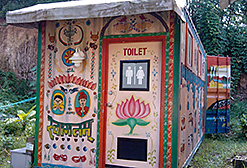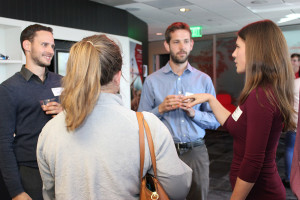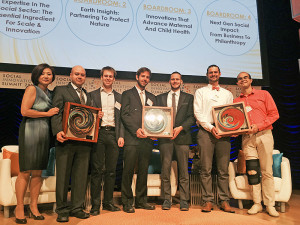Shortly after submitting our initial application for the WIP, I was called off to India to repair one of our waste water treatment systems that we had been field testing for a year in the Ahmedabad Municipal Corporation Park in Ahmedabad, Gujarat, India. My WIP teammate Clement Cid had made many such trips as well. This time, a pump was not working and because logistics and training are complicated and expensive in the developing world, it was not getting fixed. This is exactly the problem that I had written about in our WIP application, and exactly the reason why I was days late in responding to June Sugiyama the director of the Foundation’s email notifying us that we had been selected as finalists! More
Category Archives: Wireless Innovation Project
Meet the 2015 Wireless Innovation Project Winners: Seva Sustainable Sanitation (Caltech)

Meet Seva Sustainable Sanitation, first place winner in the 2015 Wireless Innovation Project. Based at Caltech, founders Clement Cid and Cody Finke are developing a low-cost, remote monitoring and maintenance system for sanitation facilities.
Images of open sewers are commonly used to depict one of the most challenging infrastructure issues of our time, one that’s impacting 2.5 billion people globally and has a wide-ranging impact on health, environment, and livelihood.
NGOs and government agencies have long focused on implementation of new sanitation technologies without a clear go-to strategy on monitoring and maintaining those systems. PhD students in Environmental Science and Engineering respectively, Cid and Finke noticed an opportunity in addressing the lack of cheap, efficient toilets but also the skills needed for repair and upkeep within local communities, especially in remote, rural areas.
Meet the 2015 Wireless Innovation Project Winners: WellDone International
Life cannot exist without water, but 748 million people today have no access to an improved water source, according to the World Health Organization. The physical results of this are staggering—600,000 children die to diarrheal diseases caused by unsafe drinking water.
Paradoxically, 2.3 billion people gained access to improved drinking water between 1990–2012 … so why hasn’t the problem been solved? The reason is clear in this startling illustration—in sub-Saharan Africa alone, one-third of rural water systems fail. The systems are there, but fall into disrepair or operate inefficiently. Monitoring rural infrastructure is expensive and time-consuming. As a result, 99% of WASH (water, sanitation and hygiene) projects lack long-term monitoring infrastructure.
WellDone International, led by Executive Director Austin McGee, CTO Tim Burke and Operations and Finance Lead Ben Armstrong, developed a solution to fill the gap in monitoring and maintaining water systems. Their mission is to build technology and tools that empower resource-constrained communities with the data they need to provide critical infrastructure that lasts.
Meet the 2015 Wireless Innovation Project Winners: Mobile Stethoscope
Meet Mobile Stethoscope Diagnostics, third place winner in the 2015 Wireless Innovation Project. Based at the MIT D-Lab, founders Rich Fletcher and Daniel Chamberlain developed a low-cost pulmonary disease diagnostic platform implemented on a mobile phone.
Pulmonary disease (which includes asthma, chronic obstructive pulmonary disease, pneumonia, lung cancer and tuberculosis) is a particularly large burden in developing countries due to a lack of air quality regulation. This can result in an abundance of air pollution from smoking and cooking on fire stoves, for example, which ultimately produces respiratory problems for people living in these areas. In addition, poor access to health care and affordable screening tools for early detection exacerbates the conditions once they start. More
Who Will be the UBER of Soup Kitchens?: How philanthropy is poised to drive tech for good
Ten years ago the startup landscape was very different. There were no accelerators, investor platforms, or founder communities. Since 2005, ecosystem players like Y Combinator and AngelList have changed how startups start. Today, the tech nonprofit landscape looks a lot like it did for startups back then. Founders are isolated, funders are ill-equipped to evaluate tech nonprofit business models, and motivated donors struggle to find good investment opportunities.
Early sector leaders like Khan Academy and Kiva demonstrate the need and models for some tech companies to adopt nonprofit business models. First, there are some problems markets can’t solve like universal education or access to financial markets for the poor. Second, while tech is capable of bringing about radical transformation, at the moment, it is exacerbating the income inequality divide. UBER, TaskRabbit, and a host of other tech services are designed for the privileged. Innovation can and should benefit more than the haves. By investing in nonprofit tech, philanthropy can level the playing field.
Vodafone Americas Foundation Names Winners for Seventh Annual Wireless Innovation Project
The Vodafone Americas Foundation unveiled the three Wireless Innovation Project winners of the $600,000 in total cash prize at the Social Innovation Summit in Washington, D.C.
VAF Celebrates the 2015 WIP Finalists

eyeMITRA and EyeNetra Look into the Future
Since winning the Vodafone Americas Foundation Wireless Innovation Project (WIP), two startups originating from the MIT Media Lab, eyeMITRA (2014) and EyeNetra (2011), continue experiencing success as they grow. Over the last six months, they garnered industry awareness, built new partnerships, and added new talent to their teams.
Vodafone Americas Foundation Names Eight Finalists for Seventh Annual Wireless Innovation Project
On April 28, the Vodafone Americas Foundation announced the eight Wireless Innovation Project finalists competing to win a total of $600,000 in grants for cutting-edge mobile innovations tackling a range of critical global issues, including health, sanitation, disaster response and access to communication. More
Bug-Sens(ing) the Next Steps
Since winning the Vodafone Americas Foundation Wireless Innovation Project (WIP) back in 2012, the Bug-Sensor team, led by Eamonn Keogh, is seeing much success with their project. Bug-Sensor’s project continues to flourish, from tackling computer science and entomological obstacles to seeing these strides published in top-tier peer-reviewed journals. In addition, their progress led to further use of the team’s sensors in labs and in the field in seven different countries. More
